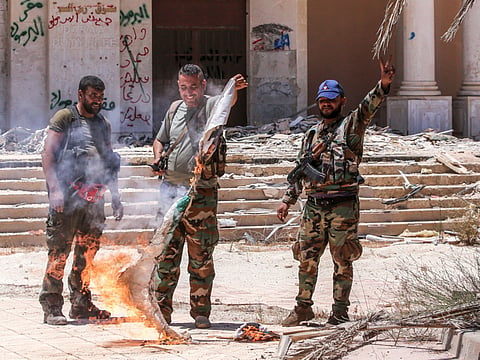Syria’s war: major regime victories
Backed by heavyweights like Russia, Iran and Hezbollah Al Assad has gained back the majority of the country

Beirut: The rebel agreement to surrender cities and towns in Syria’s southern province of Dara’a is another in a series of regime victories in the conflict that started in 2011.
Here is a recap of some of the major wins by forces of President Bashar Al Assad, who has significant backing from Russia, Iran and Lebanon’s Hezbollah group.
-2013: Strategic Qusayr -
Regime troops seized this rebel stronghold close to the Lebanese border after a blistering 17-day assault led by Hezbollah fighters.
The town was used by rebels as a transit point for weapons and fighters from Lebanon. It was also strategic for the regime because it links the capital Damascus to the coast.
- 2016: Al Assad fiefdom -
The tables started to turn in the regime’s favour when military heavyweight Russia stepped in with air strikes in 2015 to back up the Syrian army, then close to collapse.
With Moscow’s help, the regime drove rebels from their strongholds of Salma and Rabia in Latakia province on the Mediterranean coast in January 2016. Latakia is the fiefdom of Al Assad’s family.
- 2016: Second city Aleppo -
After a suffocating siege and a crushing Russian-backed offensive involving barrel bombs, rockets and shells, the army declared in December 2016 that it was in full control of Syria’s second city.
It was the regime’s biggest victory against opposition forces since the civil war erupted.
Tens of thousands of rebels and civilians were evacuated from the northern city under a deal sponsored by Iran, Russia and Turkey.
- 2017: Palmyra -
Syrian troops backed by Russian jets completed the recapture of the ancient desert town of Palmyra from Daesh in March 2017.
The oasis city had traded hands several times during the war and become a symbol of Daesh’s destruction of priceless cultural heritage in areas under its control.
- 2017: Homs, Damascus districts -
The regime regained total control of the central city of Homs in May 2017 after the Russian-supervised evacuation of rebels from their last area of control.
Syrian forces also retook three major Damascus districts: Barzeh, Qabun and Tishrin.
After losing swathes of territory, rebels had agreed to “reconciliation” deals under which they were granted safe passage to opposition-held territory elsewhere in exchange for an end to army sieges and bombardment.
- 2018: All of Damascus retaken -
A ferocious two-month military assault drove out fighters from the Eastern Ghouta rebel holdout on the doorstep of Damascus in April.
Starting in February, the Russia-backed onslaught killed more than 1,700 civilians and left much of the area in ruins.
In April the regime regained control of another region outside the capital, Eastern Qalamun.
In May it retook the Palestinian camp of Yarmouk and adjacent suburbs south of the capital after a pulverising assault that lasted nearly a month.
It meant the regime had full control of the entire capital for the first time since 2012.
- 2018: Dara’a, cradle of revolt -
The Syrian regime on July 6 reached a deal with rebels for the surrender of the remaining opposition-held cities and towns in the southern province of Dara’a, the cradle of the uprising against Al Assad.
Rebels were forced into talks after a devastating offensive, launched on June 19, which included barrel bombs and missile strikes.
The deal is important for Syria’s cross-border trade with Jordan, returning to the regime control of border crossings and observation posts.
Sign up for the Daily Briefing
Get the latest news and updates straight to your inbox



